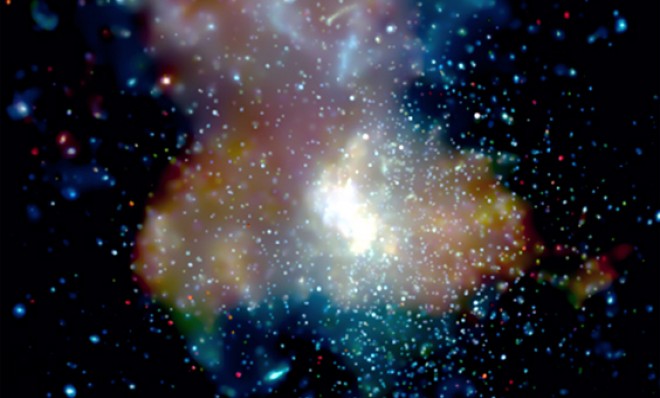How gold was born: Two neutron stars smashing together
That shiny yellow stuff is not just bling — it's a tiny piece of the universe

Gold — that soft, glimmering, reliably precious metal you should maybe consider investing in — is a fascinating element. Paired with its valuable ability to conduct electricity, it is equally comfortable hanging out in your computer keyboard as it is dangling from the neck of Jay-Z.
The question, though, of how gold came into being, chemically speaking, has long baffled scientists. Whereas lighter elements like carbon and oxygen emerged from the fusion reactions at the hearts of stars, heavy metals like platinum and gold require something with a lot more firepower.
A decade ago, a team of European scientists posited that heavy metals could be formed when two neutron stars collide into one another — an incredibly rare event that happens in the Milky Way only once every 100,000 years. (Neutron stars, as we know, are the collapsed cores of stars that have run out of steam.) Although the team's research proved that this was theoretically possible, the phenomenon has never actually been observed.
The Week
Escape your echo chamber. Get the facts behind the news, plus analysis from multiple perspectives.

Sign up for The Week's Free Newsletters
From our morning news briefing to a weekly Good News Newsletter, get the best of The Week delivered directly to your inbox.
From our morning news briefing to a weekly Good News Newsletter, get the best of The Week delivered directly to your inbox.
Until now. In a new study published in Astrophysical Journal Letters, a team of astronomers led by researcher Edo Berger of the Harvard-Smithsonian Center for Astrophysics detected a gamma-ray burst that the scientists think resulted from the crash of two distant neutron stars.
The crash, of course, was very far away — 3.9 billion light-years, in fact. Using NASA's Swift telescope, researchers noticed that the collision produced "an odd glow that lasted for days," according to the Associated Press. Upon closer inspection, the light suggested that heavy elements, including but not limited to gold, could have been produced by the incredibly rare, cosmic crash of the two dead stars.
It's beginning to look a lot like neutron stars are "a major cauldron in which elements like gold are forged," says Stockholm University astrophysicist Stephan Rosswog, who worked on the original supercomputing project. Or to put it another way: As Berger notes, anyone wearing a hint of gold on their person is walking around "with a little tiny piece of the universe."
A free daily email with the biggest news stories of the day – and the best features from TheWeek.com
-
 How to financially prepare for divorce
How to financially prepare for divorceThe Explainer Facing ‘irreconcilable differences’ does not have to be financially devastating
-
 Why it’s important to shop around for a mortgage and what to look for
Why it’s important to shop around for a mortgage and what to look forThe Explainer You can save big by comparing different mortgage offers
-
 4 ways to save on rising health care costs
4 ways to save on rising health care costsThe Explainer Health care expenses are part of an overall increase in the cost of living for Americans